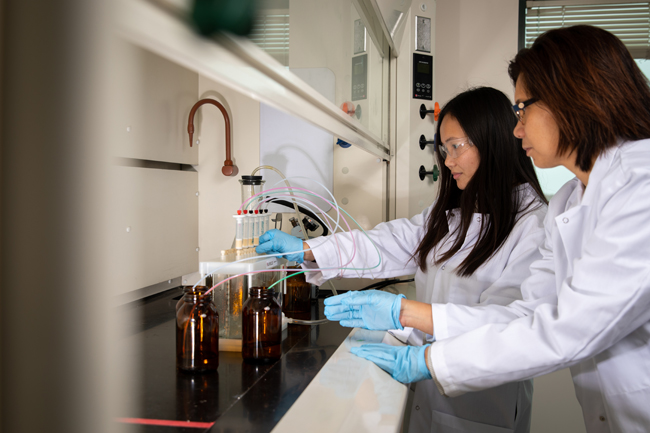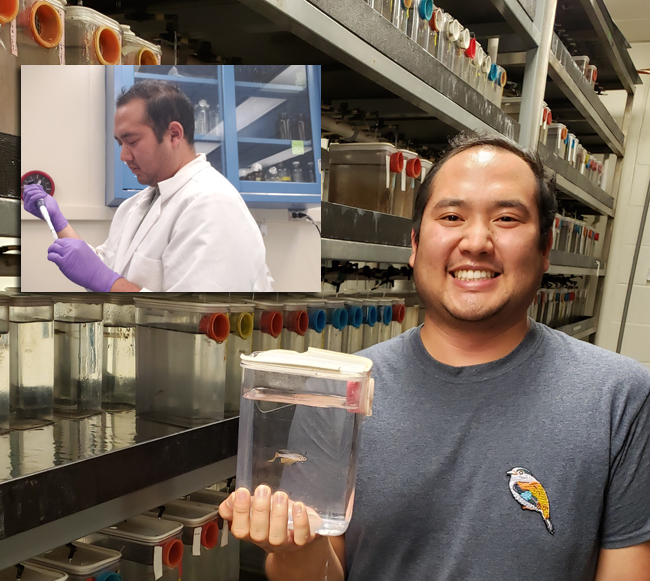
UB chemistry professor Diana Aga (right) and UB chemistry PhD candidate Luisa Angeles in the lab. To study pharmaceuticals in wastewater, they use the system pictured to isolate chemical compounds from the wastewater. Credit: Meredith Forrest Kulwicki
Published for Stony Brook University's E-news Site, Happenings
STONY BROOK, NY, January 24, 2020 - Anne McElroy, Professor and Associate Dean for Research in Stony Brook University’s School of Marine and Atmospheric Sciences (SoMAS), led a study that examined the effectiveness of different advanced treatment technologies used at seven wastewater treatment plants in the Eastern US. Co-led by Professor Diana Aga from the University at Buffalo, the full team included Associate Professors Howard Sirotkin and Bruce Brownawell from SBU and three PhD students, Luisa Angeles and Rachel Mullen from UB, and Irvin Huang from SBU.
The study, funded by New York Sea Grant, was recently published as the cover story in the journal Environmental Science: Water Research & Technology. Angeles was the first author, Mullen is now a postdoctoral fellow at Regeneron in Albany, and Irvin Huang is about to begin a National Sea Grant John A. Knauss Marine Policy Fellowship in Washington, DC.
“The number of pharmaceutically-active ingredients (API) and their known or suspected active metabolites released into surface waters is large and increasing,” said McElroy. “We need to better understand potential effects and the best ways to limit their release.”
The research highlighted the effectiveness of two treatment methods: granular activated carbon and ozonation. These techniques provided the highest level of removal of the pharmaceuticals tested, including a number of antidepressants and antibiotics, reducing effluent concentrations by more than 95% according to the scientists’ analysis.
The findings are important because any drugs discharged from treatment plants enter the environment, where they may contribute to phenomena such as antibiotic resistance, or be accumulated by wildlife. The research also demonstrated that while removal rates varied by treatment, concentrations of APIs discharged were generally very low. No changes in larval zebrafish behavior were observed after exposure to wastewater effluent extracts from any of the treatment plants studied, regardless of the mix of advanced treatment methods employed.

Irvin Huang, an advanced graduate student in SBU’s School of Marine and Atmospheric Sciences, uses molecular biology to understand the impacts of pollutants on fish health and survival. A large portion of his dissertation research took place in the lab (seen in inset). He is also pictured in SBU’s zebrafish facility. The zebrafish is a model species that can offer clues to the developmental and behavioral effects of sublethal exposure to pharmaceuticals found in wastewater effluent. Credit: Irvin Huang
“Our research adds to a growing body of work showing that advanced treatment methods, including ozonation and activated carbon, can be very effective at removing persistent pharmaceuticals from wastewater,” said McElroy.
Although this project showed no short-term behavioral effects associated with environmentally realistic levels of these drugs were found, longer term chronic effects should still be evaluated.
For more information on how to address unwanted medicines and personal care products, visit the New York Sea Grant website. You can also help protect New York’s waterways by participating in Drug Take Back Day.
More Info: New York Sea Grant
New York Sea Grant (NYSG), a cooperative program of Cornell University
and the State University of New York (SUNY), is one of 34 university-based
programs under the National Oceanic and Atmospheric Administration’s
National Sea Grant College Program.
Since 1971, NYSG has represented a statewide network of integrated
research, education and extension services promoting coastal community
economic vitality, environmental sustainability and citizen awareness
and understanding about the State’s marine and Great Lakes resources.
Through NYSG’s efforts, the combined talents of university scientists
and extension specialists help develop and transfer science-based
information to many coastal user groups—businesses and industries,
federal, state and local government decision-makers and agency managers,
educators, the media and the interested public.
The program maintains Great Lakes offices at Cornell University, SUNY
Buffalo, SUNY Oswego and the Wayne County Cooperative Extension office
in Newark. In the State's marine waters, NYSG has offices at Stony Brook
University in Long Island, Brooklyn College and Cornell Cooperative
Extension in NYC and Kingston in the Hudson Valley.
For updates on Sea Grant activities: www.nyseagrant.org has RSS, Facebook, Twitter, and YouTube links. NYSG offers a free e-list sign up via www.nyseagrant.org/nycoastlines for its flagship publication, NY Coastlines/Currents, which is published quarterly. Our program also produces an occasional e-newsletter,"NOAA Sea Grant's Social Media Review," via its blog, www.nyseagrant.org/blog.